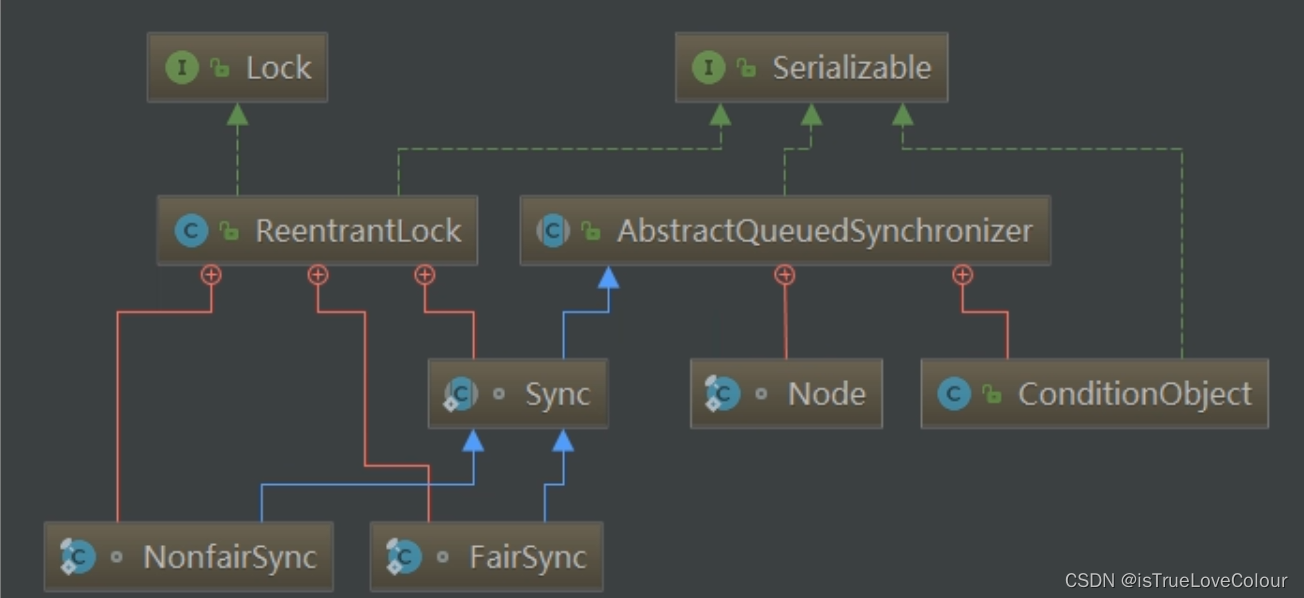AQS 抽象队列同步器
发布时间:2024年01月07日
AQS
AQS (抽象队列同步器): AbstractQueuedSynchronizer 是什么
- 来自jdk1.5,是用来实现锁或者其他同步器组件的公共基础部分的抽象实现,是重量级基础框架以及JUC的基石,主要用于解决锁分配给谁的问题
- 整体是通过一个抽象的FIFO队列来完成资源获取线程的排队工作,并通过一个int变量表示持有锁的状态
- 锁是面向开发人员的,而同步器是JDK统一规范并简化了锁的实现,并抽象出来的公共基础部分,屏蔽了同步状态、同步队列的管理,和线程排队、通知、唤醒等机制
和AQS相关的类有:
- ReentranLock
- CountDownLatch
- ReentrantReadWriteLock
- Semaphore
- 等

AQS 原理
- 整体是通过一个抽象的FIFO队列来完成资源获取线程的排队工作,并通过一个int变量表示持有锁的状态
- 如果共享资源被占用,就需要阻塞唤醒机制来保证锁的分配,这个机制主要是通过CLH队列的变体实现的,将暂时获取锁失败的线程,以及自身的等待状态封装成队列的节点对象node,放入队列中
- 通过CAS、自旋等维护共享资源的状态,达到并发效果
- 内部结构:
- 队列的 头指针、尾指针
- int 类型的同步状态的标识 state ,默认值0代表没有被占用,大于等于1代表被占用
- 内部类node,将暂时获取锁失败的线程,以及自身的等待状态封装成队列的节点对象node
- int类型变量 waitStatus 当前节点再队列中的等待状态,默认为0
- 1表示线程被取消
- -1表示后继线程需要被唤醒
- -2表示等待conditon唤醒
- -3表示共享式(锁分为共享和独占)同步状态获取将无条件地传播下去
- 前一个节点的指针和后一个节点的指针
- 请求线程
- int类型变量 waitStatus 当前节点再队列中的等待状态,默认为0
CLH队列
- (Craig, Landin,Hagersten) 三个科学家名字的简称
- 通过state状态判断是否阻塞,从尾部入队,头部出队
以ReentrantLock为例,加锁和解锁的步骤为:
lock
-
当调用 lock 方法加锁时
- 非公平锁,会先尝试通过cas 比较并交换的操作把 states 的状态值从 0更新为1,如果更新成功,就把持有锁的线程设置为自己
- 更新失败就和公平锁一样,执行 AQS 的 acquire方法
- 除此之外,公平和非公平锁的区别就是,再获取同步状态时,公平锁需要判断等待队列中再自己之前是否存在有效节点,如果有公平锁就需要排队
- 因为公平锁讲究先到先得,线程再获取锁时,如果这个锁的等待队列已经有线程再等待,当前线程就会直接进入等待队列
- 而非公平锁,不管是否有队列,如果可以获取锁,就会立刻占有锁的对象,所以第一个在队列里排队的线程苏醒后,仍然需要去竞争锁,且不一定能竞争到锁
acquire 方法源码:
public final void acquire(int arg) {
if (!tryAcquire(arg) &&
acquireQueued(addWaiter(Node.EXCLUSIVE), arg))
selfInterrupt();
}
acquire
- 调用lock方法加锁,除非是非公平锁能直接拿到锁,其他情况下都是在调用acquire 方法
- acquire 方法分为三种情况:
- 调用 tryAcquire 方法尝试加锁;
-
AQS类的tryAcquire方法只是做了规范,方法内直接抛出异常,所以这个方法需要由子类去实现
-
非公平锁的tryAcquire 方法会先判断锁的状态state是否为0,为0说明没有被其他线程占用,就立即使用cas操作变更state为1,变更成功就把持有锁的线程设置为自己,变更失败就表示加锁失败
-
如果锁的状态为1,说明锁已经被占用,在比较当前线程和持有锁的线程是否一致,不一致就加锁失败
-
tryAcquire 方法公平和非公平锁的区别是
- 再获取同步状态时,公平锁需要判断等待队列中再自己之前是否存在有效节点,如果有公平锁就需要排队
- 非公平锁,不管是否有队列,如果可以获取锁,就会立刻占有锁的对象
-
如果 tryAcquire 方法抢锁失败,就需要调用 addWaiter加入到等待队列
-
- 加锁失败,调用 addWaite方法,进入等待队列;
- acquire 方法的 addWaiter 方法创建的是独占的node节点,节点中封装的是当前线程
- 首先要判断 链表的尾指针是否为空
- 如果为空,就需要初始化链表,首先new一个空的哨兵节点,这个节点并不存储信息,只是作为占位使用,然后设置哨兵节点为头节点,然后把头节点赋值给尾节点
- 当链表初始化完成后,或者链表中已经由其他节点时,就用CAS操作把新节点加入到链表尾部,如果节点加入链表失败就进行下一次循环,直到把节点加入成功为止
- 如果不为空,直接用CAS操作把新节点加入到链表尾部,同样如果节点加入链表失败就进行循环,直到把节点加入成功为止
- 节点成功入队后,需要调用acquireQueued 方法
- 进入队列之后,调用acquireQueued 方法,线程进入阻塞状态,等待唤醒后才能继续执行
- 首先获取当前节点的前置节点,如果前置节点是头节点,就尝试去获取锁
- 如果获取锁成功,就把自己设为头节点,就把锁的state改为1,设置当前线程为持有锁的线程
- 如果前置节点不是头节点,或者获取锁失败
- 就需要判断前置节点的waitStatus状态值,waitStatus值默认为0,第一次进入循环,会把前置节点的waitStatus的值改为-1后,继续下一次循环后,会调用 LockSupport.park 方法阻塞当前线程,需要等待其他线程释放锁后,再唤醒阻塞的线程
- 当持有锁的线程释放锁,且调用LockSupport.unpark 唤醒该线程后才能继续执行,LockSupport.unpark 唤醒的是头节点的下一个节点
- 线程被唤醒后,检查线程是否被中断,如果线程没有被中断,就继续进行循环
- 继续尝试去加锁,因为是非公平锁,所以有可能会加锁失败
- 如果加锁成功,就把锁的state改为1,设置当前线程为持有锁的线程,并且把当前线程的节点设置为链表的头节点,原本的头节点会从链表中剔除
- 因为每次唤醒的都是头节点的下一个节点,所以成功抢到到锁后,被唤醒的节点会成为新的头节点,后续会唤醒链表的下一个节点
- 如果线程在等待过程中取消,没有获取到锁就跳出了循环,failed值为默认的true,就会执行cancelAcquire方法,取消正在排队的节点
- 首先设置当前节点的线程为null,然后获取上一个没有取消的前置节点,
- 把当前节点的 waitStatus 设置为1(1就是要取消的节点)
- 如果当前节点是尾节点,就把上一个有效的节点设置为尾节点
- 如果不是尾节点,并且满足出队条件,就变更链表中相关节点的前置和后置引用,剔除要取消的节点
非公平锁的 tryAcquire 方法源码
final boolean nonfairTryAcquire(int acquires) {
final Thread current = Thread.currentThread();
int c = getState();
//先判断锁的状态state是否为0,为0说明没有被其他线程占用
if (c == 0) {
//为0说明没有被其他线程占用,使用cas操作变更state为1
if (compareAndSetState(0, acquires)) {
//变更成功就把持有锁的线程设置为自己,变更失败就表示加锁失败
setExclusiveOwnerThread(current);
return true;
}
}
//如果锁的状态为1,说明锁已经被占用,在比较当前线程和持有锁的线程是否一致
else if (current == getExclusiveOwnerThread()) {
int nextc = c + acquires;
if (nextc < 0) // overflow
throw new Error("Maximum lock count exceeded");
setState(nextc);
return true;
}
//加锁失败
return false;
}
addWaiter(Node.EXCLUSIVE) 加入等待队列 源码:
- Node.EXCLUSIVE 代表的是独占的节点,也就是排他锁
private Node addWaiter(Node mode) {
//node节点中封装的是当前线程
Node node = new Node(Thread.currentThread(), mode);
//尾指针
Node pred = tail;
//链表的尾指针是否为空
if (pred != null) {
node.prev = pred;
//如果加入失败,就会走下面的循环,直到把节点加入链表为止
if (compareAndSetTail(pred, node)) {
pred.next = node;
return node;
}
}
enq(node);
return node;
}
private Node enq(final Node node) {
for (;;) {
//尾节点
Node t = tail;
//如果尾节点为null
if (t == null) { // Must initialize
//就需要new一个node节点,并且设置为头节点,然后把头节点赋值给尾节点
if (compareAndSetHead(new Node()))
tail = head;
} else {
//当链表初始化完成后,或者链表中已经由其他节点时
//把要加入链表的新节点的前指针设置为尾节点
node.prev = t;
//并且把新加入的节点设置为尾节点
if (compareAndSetTail(t, node)) {
//设置成功就之前尾节点的后指针指向新节点,这样新节点就变成了新的尾节点,如果设置失败,就继续循环,直到把新节点加入到链表尾部为止
t.next = node;
return t;
}
}
}
}
acquireQueued 源码
- 线程进入阻塞状态,等待唤醒后才能继续执行
//arg为1,独占锁
final boolean acquireQueued(final Node node, int arg) {
boolean failed = true;
try {
boolean interrupted = false;
for (;;) {
//获得node节点的前置节点
final Node p = node.predecessor();
//node节点的前置节点是否为头节点,如果是就尝试去获取锁
if (p == head && tryAcquire(arg)) {
setHead(node);
p.next = null; // help GC
failed = false;
return interrupted;
}
//判断node节点的前置节点的waitStatus状态,默认情况下都是0,在第二次循环的时候,就会改成-1,然后执行parkAndCheckInterrupt方法
//parkAndCheckInterrupt方法会阻塞当前线程
//也就是后面的节点会把前面节点的 waitStatus 改为-1
if (shouldParkAfterFailedAcquire(p, node) &&
parkAndCheckInterrupt())
interrupted = true;
}
} finally {
if (failed)
cancelAcquire(node);
}
}
/**
* waitStatus 当前节点再队列中的等待状态
默认为0
1表示线程获取锁的请求被取消
-1表示线程已经准备好了
-2表示节点在等待队列中,等待唤醒
-3表示共享式(锁分为共享和独占)同步状态获取将无条件地传播下去
*/
private static boolean shouldParkAfterFailedAcquire(Node pred, Node node) {
//前置节点的状态
int ws = pred.waitStatus;
// SIGNAL= -1 , 当线程再次进行循环的时候,前一个节点的waitStatus已经被设置为-1,就返回true
if (ws == Node.SIGNAL)
return true;
//线程被取消
if (ws > 0) {
do {
node.prev = pred = pred.prev;
} while (pred.waitStatus > 0);
pred.next = node;
} else {
//如果前置节点的 waitStatus不等于-1也不大于0,就把waitStatus的值改为-1后,返回false
compareAndSetWaitStatus(pred, ws, Node.SIGNAL);
}
return false;
}
//阻塞当前线程
private final boolean parkAndCheckInterrupt() {
//验证当前线程的通行证,阻塞当前线程
LockSupport.park(this);
//被唤醒后,检查线程是否被中断,如果线程没有被中断,就返回 false
return Thread.interrupted();
}
取消正在进行的获取尝试
// node 为需要取消的节点
private void cancelAcquire(Node node) {
// Ignore if node doesn't exist
if (node == null)
return;
//设置当前节点的线程为null
node.thread = null;
//获取上一个节点
Node pred = node.prev;
//waitStatus > 0 ,表示上一个节点也要取消
while (pred.waitStatus > 0)
//那么就一直向上找,直到找到没有取消的前置节点
node.prev = pred = pred.prev;
//获取不会取消的前置节点的下一个节点
Node predNext = pred.next;
//把当前节点的 waitStatus 设置为1,1就是要取消的节点
node.waitStatus = Node.CANCELLED;
//如果当前节点是尾节点,就把上一个还有效的节点设置为尾节点
if (node == tail && compareAndSetTail(node, pred)) {
//设置成功,就把上一个节点的后置节点设置为null,这样上一个还有效的节点就成为了尾节点
compareAndSetNext(pred, predNext, null);
} else {
//否则
int ws;
//前置节点不能是头节点,因为头节点只是占位节点,并且满足出队条件
if (pred != head &&
((ws = pred.waitStatus) == Node.SIGNAL ||
(ws <= 0 && compareAndSetWaitStatus(pred, ws, Node.SIGNAL))) &&
pred.thread != null) {
//变更链表中相关节点的前置和后置引用,剔除要取消的节点
Node next = node.next;
if (next != null && next.waitStatus <= 0)
compareAndSetNext(pred, predNext, next);
} else {
unparkSuccessor(node);
}
node.next = node; // help GC
}
}
unlock
unlock 源码,其实是再调用release方法
public void unlock() {
sync.release(1);
}
release方法会首先尝试释放锁
- tryRelease 会把持有锁的线程为null,并且把锁的state设置为0
- 如果链表被初始化过,有在等待的线程节点,头节点就不为空,且waitStatus值为-1
- 接下来会把头节点的waitStatus的改为0,如果头节点的下一个节点不为null,就调用LockSupport.unpark 方法,唤醒头节点的下一个节点
public final boolean release(int arg) {
if (tryRelease(arg)) {
Node h = head;
if (h != null && h.waitStatus != 0)
unparkSuccessor(h);
return true;
}
return false;
}
AQS的tryRelease方法,同样没有做实现,需要子类自己去实现,下面是ReentrantLock的实现
protected final boolean tryRelease(int releases) {
//传入的releases为1,持有锁的线程State为1,所以C为0
int c = getState() - releases;
//如果当前线程不等于持有锁的线程会抛出异常,这种情况一般不会出现
if (Thread.currentThread() != getExclusiveOwnerThread())
throw new IllegalMonitorStateException();
boolean free = false;
//c等于0,就设置持有锁的线程为null,并且把state设置为0,返回true
if (c == 0) {
free = true;
setExclusiveOwnerThread(null);
}
setState(c);
return free;
}
unparkSuccessor
private void unparkSuccessor(Node node) {
int ws = node.waitStatus;
if (ws < 0)
//重新把头节点的waitStatus值改为0
compareAndSetWaitStatus(node, ws, 0);
//头节点的下一个节点
Node s = node.next;
//如果链表被初始化过,有在等待的线程节点,头节点的后置节点就不为null
//如果链表后面还有其他节点,那么头节点的后置节点waitStatus值就为-1
if (s == null || s.waitStatus > 0) {
s = null;
for (Node t = tail; t != null && t != node; t = t.prev)
if (t.waitStatus <= 0)
s = t;
}
//如果头节点的下一个节点不为null,就直接调用 LockSupport.unpark 方法,唤醒头节点的下一个节点
if (s != null)
LockSupport.unpark(s.thread);
}
文章来源:https://blog.csdn.net/persistence_PSH/article/details/135441801
本文来自互联网用户投稿,该文观点仅代表作者本人,不代表本站立场。本站仅提供信息存储空间服务,不拥有所有权,不承担相关法律责任。 如若内容造成侵权/违法违规/事实不符,请联系我的编程经验分享网邮箱:chenni525@qq.com进行投诉反馈,一经查实,立即删除!
本文来自互联网用户投稿,该文观点仅代表作者本人,不代表本站立场。本站仅提供信息存储空间服务,不拥有所有权,不承担相关法律责任。 如若内容造成侵权/违法违规/事实不符,请联系我的编程经验分享网邮箱:chenni525@qq.com进行投诉反馈,一经查实,立即删除!
最新文章
- Python教程
- 深入理解 MySQL 中的 HAVING 关键字和聚合函数
- Qt之QChar编码(1)
- MyBatis入门基础篇
- 用Python脚本实现FFmpeg批量转换
- 3. 第三章 函数
- imgaug库指南(27):从入门到精通的【图像增强】之旅
- 142.环形链表 II 、141. 环形链表(附带源码)
- PostgreSQL(Linux版本:16.1)
- 扩展服务集
- python 实战:爬取全国星巴克门店信息,上海竟有 1115 个门店!
- 怎么选择数据安全交换系统,能够防止内部员工泄露数据?
- HttpRunner自动化测试之实现参数化传递
- 基于leaflet地图实现点击点位图标,在图标边上展示信息弹窗的方案
- C++ 类型转换